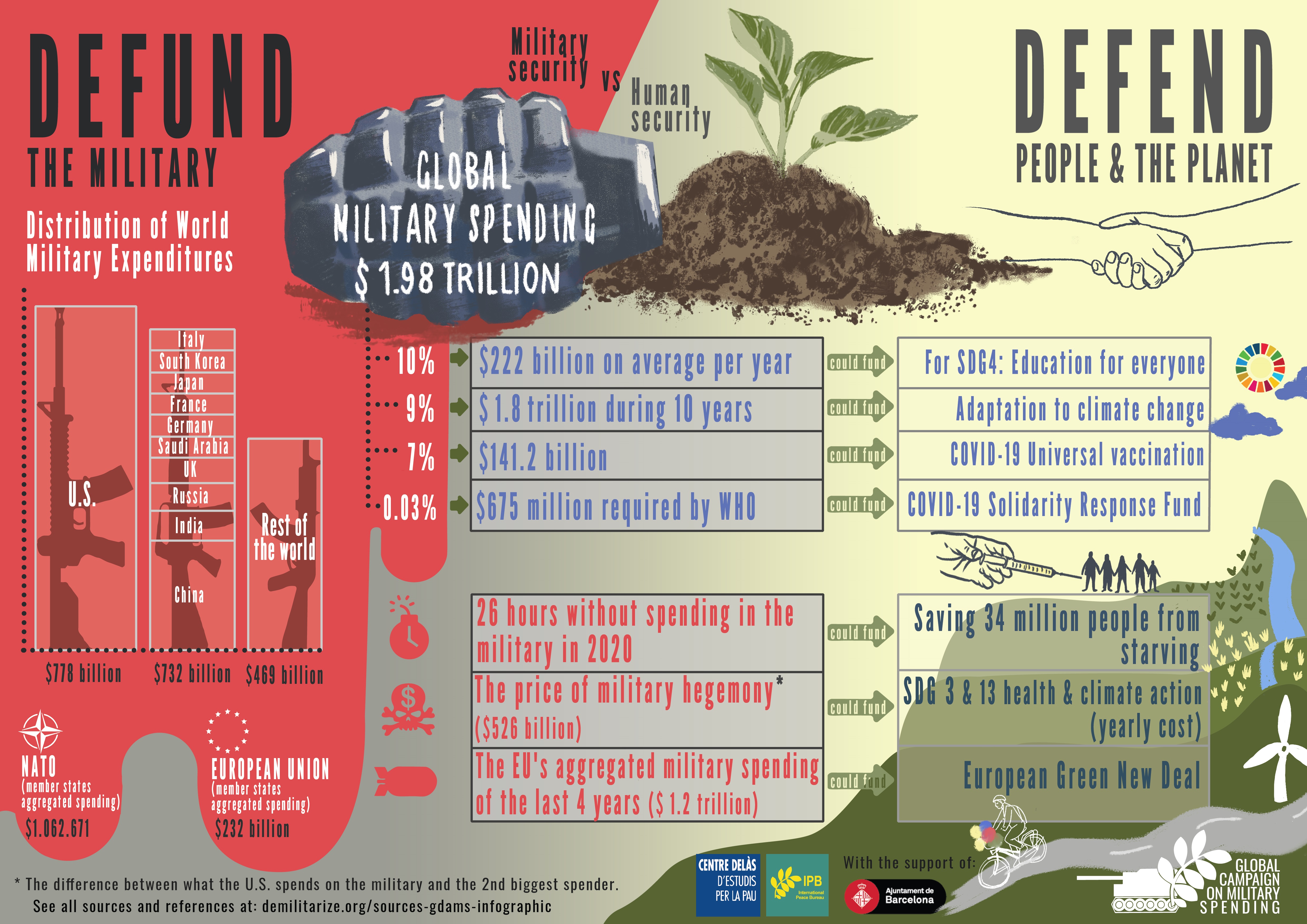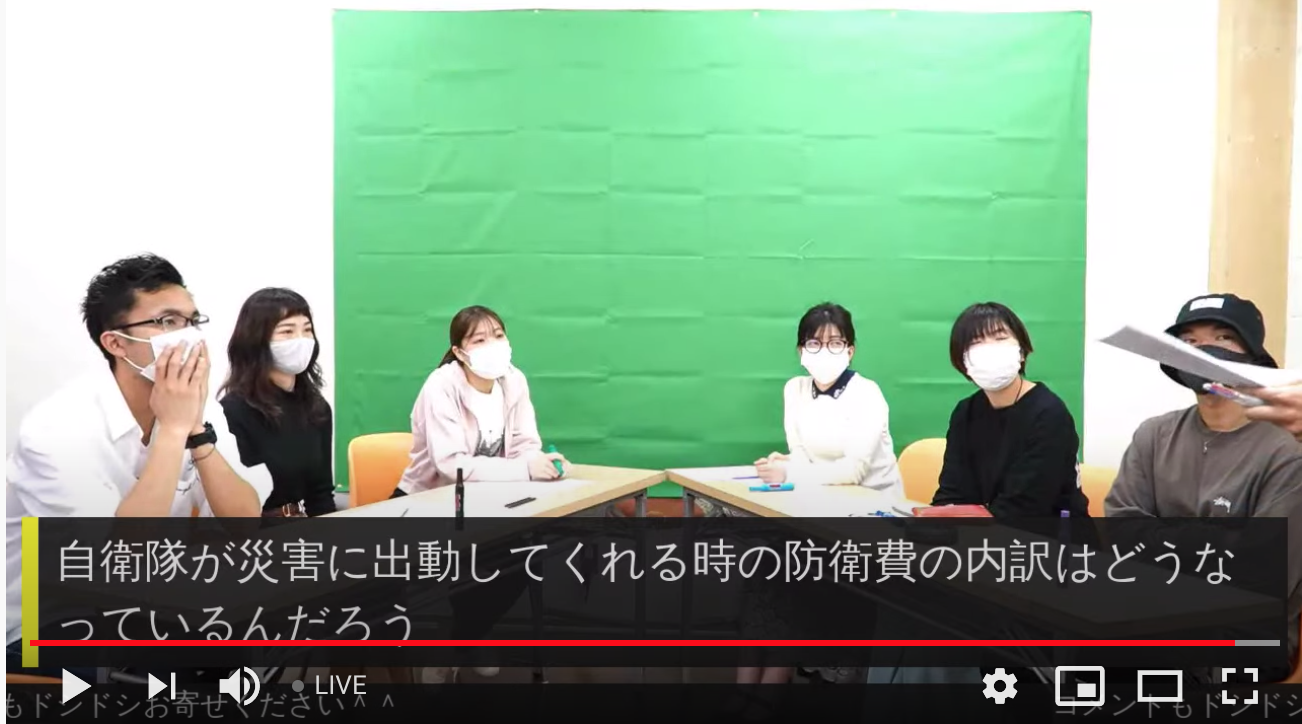
News
Global Days of Action on Military Spending (GDAMS)
This year, the Global Days of Action on Military Spending (GDAMS), organized by the Global Campaign on Military Spending, a year-round international campaign promoted by the International Peace Bureau took place from 12 April -17 May. The Stockholm Peace Research Institute (SIPRI) released the data for global military spending on April 26. World military expenditure was 1981 billion USD in 2020, an increase of 2.6 per cent from 2019 in real terms. Since clear records began in 1988, there has been a steady overall increase. The five biggest spenders in 2020 were the United States, China, India, Russia and the United Kingdom, which together accounted for 62 per cent of world military spending. Japan is at number 9 in the world and the second largest military spender in East Asia in 2020, behind China.

Various organizations around the world organized awareness raising events during GDAMS to highlight how much had been spent on the military worldwide. Peace Boat as a International Steering Group Member of GCOMS, also took part in the campaign. An event was organized in Japan specifically to raise awareness particularly of Japan’s military spending, entitled “Japan's military spending is 5.3 trillion yen?!- how do we protect people and the planet?” It was a hybrid event with the first half featuring an online presentation on global and Japanese military spending. The second half was a small in-person workshop held in the Peace Boat in Japan with Peace Boat volunteers. The whole event was broadcast on Facebook, Youtube and to the Peace Boat Online Community - OCEAN- which was launched during the pandemic. Viewers were invited to comment live during the event.
In spite of Article 9 of the Japanese Constitution, a clause in the national Constitution of Japan outlawing war as a means to settle international disputes involving the state, Japan's “defense” spending in 2020 was 49.1 billion USD / 5.3 trillion yen. This is an increase of 1.1% from the previous year, and defense spending has increased for the eighth consecutive year since the beginning of the second Abe administration, and has reached a record high for the sixth consecutive year. At 1% of GDP, Japan’s military burden in 2020 reached the self-imposed limit that the Japanese cabinet set in 1976. Japan last reached this limit in 2015. As well as looking at the figures released by SIPRI for Japan, Peace Boat staff member, Karen Hallows, who gave the presentation explained that the Japanese government approved in December a record defense budget for fiscal 2021 totaling 5.34 trillion yen. The draft budget is up 0.5 percent from fiscal 2020, including expenses connected to hosting the US' military bases.
 The event highlighted that the issue of military spending is important because an increase in militarisation means increased possibility of armed conflict but also it is a question of priorities for public money. Many of the security threats facing our world including the current COVID-19 pandemic cannot be resolved through increased arms. The presentation showed examples from the GDAMS campaign about alternatives for global military spending. 222 billion USD every year could be used to implement SDG4 and provide education for everyone. 1.8 trillion USD over 10 years for climate change adaptation and finally 141.2 billion USD for universal COVID-19 vaccine. Looking at the situation in Japan, Karen showed how the some of the money used for the military could be used to deal with COVID-19. Converting JS Izumo (DDH-183), a helicopter carrier into a light aircraft carrier costs 3.1 billion yen. Purchasing from the US 6 stealth fighter F-35Bs operated by the ship from the US is 79.3 billion yen. A total of 82.4 billion yen. With this amount of money, more than 130 PCR testing centers can be set up nationwide. The land-based missile interception system Aegis Ashore cost 12.9 billion yen. With this amount, we can increase the number of helpers who care for the elderly by 4,000.
The event highlighted that the issue of military spending is important because an increase in militarisation means increased possibility of armed conflict but also it is a question of priorities for public money. Many of the security threats facing our world including the current COVID-19 pandemic cannot be resolved through increased arms. The presentation showed examples from the GDAMS campaign about alternatives for global military spending. 222 billion USD every year could be used to implement SDG4 and provide education for everyone. 1.8 trillion USD over 10 years for climate change adaptation and finally 141.2 billion USD for universal COVID-19 vaccine. Looking at the situation in Japan, Karen showed how the some of the money used for the military could be used to deal with COVID-19. Converting JS Izumo (DDH-183), a helicopter carrier into a light aircraft carrier costs 3.1 billion yen. Purchasing from the US 6 stealth fighter F-35Bs operated by the ship from the US is 79.3 billion yen. A total of 82.4 billion yen. With this amount of money, more than 130 PCR testing centers can be set up nationwide. The land-based missile interception system Aegis Ashore cost 12.9 billion yen. With this amount, we can increase the number of helpers who care for the elderly by 4,000.
Following the online presentation on military spending, Sumiko Hatakeyama led a small in-person workshop and discussion on military spending with Peace Boat volunteers at the Peace Boat Center in Tokyo. The young participants expressed their surprise at the high level of spending and engaged in a lively discussion about how that money could be spent. Concluding the workshop, the youth volunteers wrote their ideas for prioritising the money on pieces of paper. These included rural regeneration, maternal health and child care and a ‘planet revival project’.

Peace Boat staff also took part in the GDAMS selfie campaign, showing their priorities on how the 1981 billion USD military budget could be better spent. Ideas from staff members included education, support for the homeless, medical care and climate action. Global Military spending was also included in an event on Military Artificial Intelligence in a Study Session that was organized as part of Peace Boat’s regular online educational programme while the ship is unable to sail.
Peace Boat staff member, Meri Joyce, joined the closing event for GDAMS which was held at the Asia Europe People’s Forum. Meri speaking on behalf of Peace Boat shared the situation in Japan in regards to military spending explaining that most of Peace Boat’s work is focused on raising awareness in Japan because most people are not aware of how much Japan spends on ‘defence’ because of the image of a peaceful country with Article 9. Meri explained that at the same time, Japan is going through the third state of emergency connected with the third wave of the COVID-19 pandemic. Meri explained that it is not unrelated that Okinawa, which is home to most of the US bases in Japan, also has the highest COVID-19 infection rate in the country.


